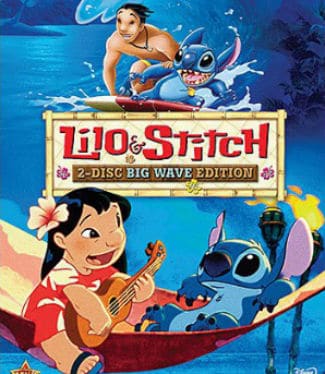
Welcome to Revisiting Disney! This week, we’re looking at a Disney movie that is beautiful and heartfelt, Lilo & Stitch!! Like always, I have labeled each category so if you want to skip to the parts that interest you most, feel free. And, of course, if you have any thoughts, burning or otherwise, please share in the comments!
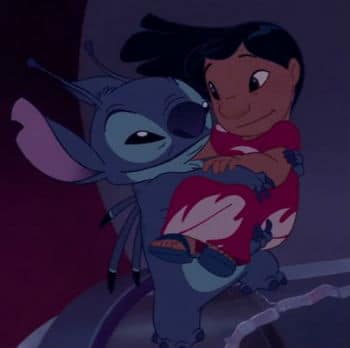
BACKGROUND OF LILO & STITCH
Released on June 21st, 2002, Lilo & Stitch was written and directed by Chris Sanders and Dean Dubois, both of whom had worked for Disney in the past. Dubois had served as co-writer on Mulan and would later work on Lilo & Stitch, its sequels and Lilo & Stitch: The Series. He also worked/is working on the How to Train Your Dragon series, and worked for Don Bluth and his animation studio before working for Disney (also serving on the animation team for Atlantis: The Lost Empire). Chris Sanders worked on the stories for Beauty & the Beast, Aladdin, The Lion King, Mulan, Lilo & Stitch, Lilo & Stitch: The Series, the Lilo & Stitch sequels, and would later work on How to Train Your Dragon and The Croods. He also worked on The Rescuers Down Under.
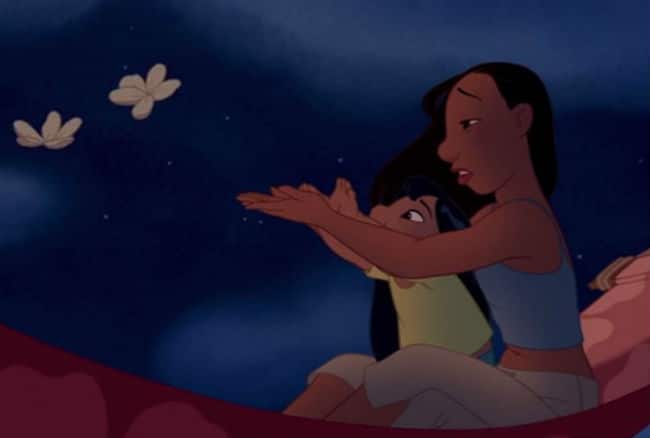
Photo: Disney
Lilo & Stitch was the product of a Studio meeting that prompted the team to, as Thomas Schumacher, the President of Walt Disney Feature Animation put it, to look for “the Dumbo of our generation,” a movie that was simpler than the big epics but still had a lot of heart. Roy Disney recalls that the Studio had been looking for epic stories and that they realized that they could really be just as successful with the simpler stories; they can touch people too.
Thomas Schumacher and Michael Eisner wanted a more technologically simple idea that could touch the heart and take story risks, and Schumacher approached Chris Sanders to see if he had an idea. In the 1980’s, Sanders had tried to write a children’s book about this character, Stitch, and although it hadn’t worked out in that format, he thought it might be a good film.
According to the IMDB page, Lilo & Stitch and The Princess and the Frog, were the only two Disney movies in the 2000s (just the first decade), to actually get critical acclaim (and to make back the cost of production). This isn’t strictly true, as at the 2002 Academy Awards, three nominations for Best Animated Feature had come out of Disney-Spirited Away, Treasure Planet, and Lilo & Stitch. Fun fact-Daveigh Chase voiced both Lilo and the English dub for Chihiro/Sen in Spirited Away.
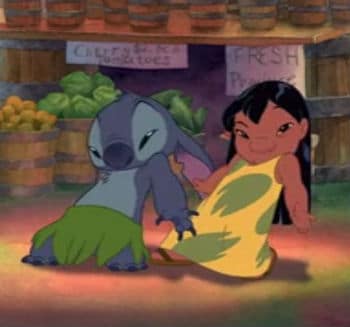
Photo: Disney
Personally, I love the films that come after the Disney Renaissance technically ends. Dinosaur, The Emperor’s New Groove, Atlantis, Brother Bear, Treasure Planet, and Lilo & Stitch were all gutsy films that did something different and tried out a new technology or animation style, or just told a brave story. They remind me a lot of the anthology films of the 1940s because it seems like they often get lost in the shuffle. People love them, don’t get me wrong, but these six films are wonderfully innovative.
MUSIC
Lilo & Stitch has a lot of great music and utilizes many Elvis songs that were under license from BMG Special Products. They also use “Burning Love,” performed by Wynonna Judd, and “Can’t Help Falling In Love,” performed by the A*Teens.
Three other songs were included, however, and these were written by Alan Silvestri and Mark Keali’i Ho’omalu (though “Aloha Oe” was written by Queen Liliuokalani). The song “He Mele No Lilo” was performed by Mark Keali’i Ho’omalu, and “Hawaiian Roller Coaster Ride” was performed by Mark Keali’i Ho’omalu and the Kamehameha Schools Children’s Chorus.
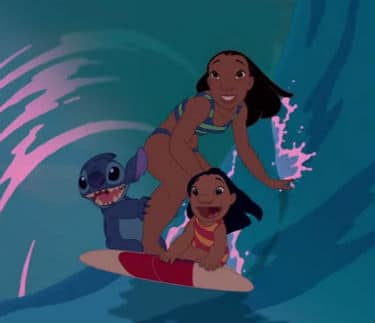
Photo: Disney
The score for Lilo & Stitch was composed by Alan Silvestri, the composer of Forrest Gump, The Mummy, Cast Away, Back to the Future, Contact, Who Framed Roger Rabbit?, Romancing the Stone, and The Mummy Returns. He would go on write the music for Night at the Museum, Van Helsing, Captain America, The Avengers, The Polar Express, and The Croods.
He was the first pick of Sanders and Dubois to write the music; Dubois calls his work the “right blend of whimsy and sincerity” to make Lilo & Stitch the movie that they wanted it to be. Since the film was a mix of whimsy and sincerity itself, the powers at Disney agreed with the choice and supported the directors in that hire.
ANIMATION
The backgrounds for Lilo & Stitch were made using watercolors, and it was the first Disney movie since Dumbo to use that technique. Lilo & Stitch was also unique in that it only had a few scenes that used the multiplane camera technique that had been used so much in other films of this era, particularly Tarzan, Atlantis, and Treasure Planet.
Watercolor is, apparently, a very challenging and intimidating medium to use, so the fifteen animators that were sent out to create the backgrounds were, according to the behind-the-scenes footage, a tad nervous at first. However, the backgrounds are absolutely stunning, and I think it was worth it.
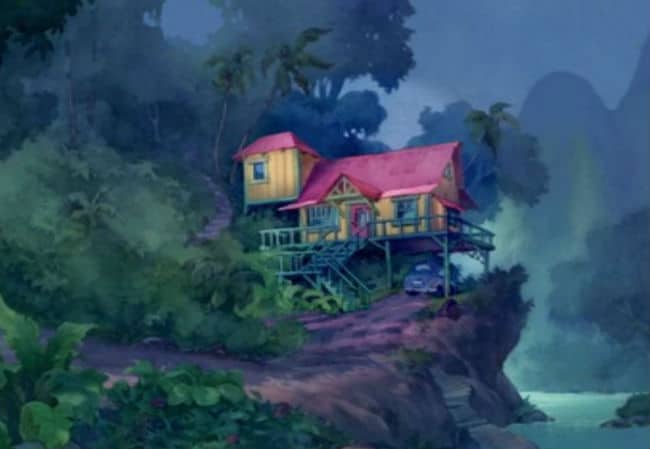
Photo: Disney
The backgrounds were also interesting because, on the commentary, Sanders and Dubois talk about how the scenes in space used a lot of blues and cool colors while the scenes in Hawaii were made to contrast that, using a lot of warm colors.
PLOT
Lilo & Stitch is the story of Experiment 626, an alien experiment made by Dr. Jumba. Stitch is the evidence at the intergalactic trial of his creator, and while Jumba is sentenced to life in prison, Experiment 626 is set up for exile. While he is being transported to his prison by Captain Gantu, 626 manages to escape and finds himself on Earth. Being unable to survive in water, 626 is lucky enough to land on the island of Kaua’i.
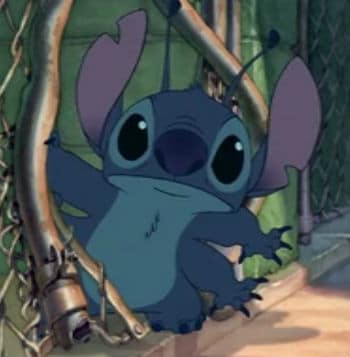
Photo: Disney
When the Grand Councilwoman of the Intergalactic Council discovers he has escaped, she sends his creator Jumba after him, with the Earth Expert from the Federation, Agent Pleakley, to keep an eye on him. As the two of them chase after 626, the little menace gets adopted by a lonely little girl named Lilo.
Lilo is a little girl being raised by her sister, Nani, after their parents tragically die (before the events of the film). Lilo is lonely and strange (wonderful, but odd), and Nani is also fairly young. Their relationship, Lilo and Stitch’s relationship, and the addition of Stitch into Lilo and Nani’s already chaotic and confusing lives, form the heart of the movie.
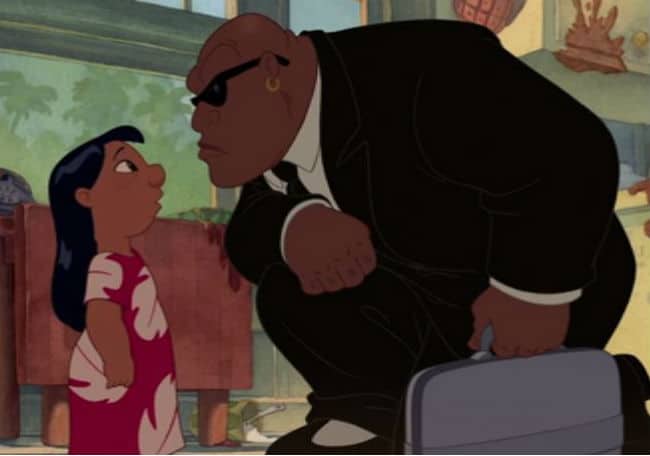
Photo: Disney
As the story unfolds, Stitch tries to avoid being caught by Jumba and Pleakley, Nani struggles to raise and care for her sister despite her own very young age, Stitch begins to understand what family is and realize that he wants it, Lilo tries to help Stitch become good, Captain Gantu arrives to take Stitch back to prison, and the Social Worker Cobra Bubbles has to make hard choices about whether staying with her sister really is the best choice for Lilo.
Will Lilo and Nani be able to stay together? What will happen to Stitch? Will Nani agree to go on a date with David, the best Disney Prince who isn’t actually a prince (and is a solid best friend despite her chaotic life), after the movie end? Can Stitch truly be part of their family? Will anyone ever realize that there are aliens invading Hawaii? These questions and more are answered in Lilo & Stitch.
SOURCE MATERIAL
Lilo & Stitch, like I mentioned above, was a story that Chris Sanders had been thinking about for quite a while. Originally, the story was set in Kansas with no Lilo, just Stitch. He was an alien who had crash-landed there and didn’t get along with the forest animals. However, Schumacher suggested that the “confused alien” story might be more fun if Stitch was living among humans.
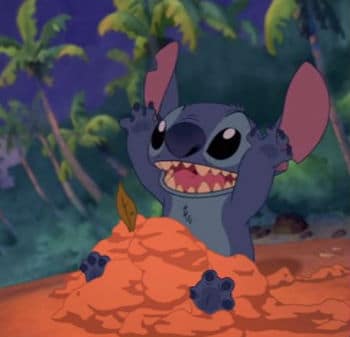
Photo: Disney
Since the story was supposed to be in an isolated place (Sanders said that he wanted to make sure that the army didn’t show up to get Stitch), they had to be somewhere remote). When the production team remembered Hawaii, particularly the island of Kaua’i, they realized that they had found the beautiful atmosphere they had been looking for.
Jason Scott Lee (the voice of David) and Tia Carrere (the voice of Nani) were both born in Hawaii and helped the writers make sure that the dialog and accents were accurate. When it came time to film the hula scenes, the team was determined to accurately portray the dances. They attended a halau, or hula school, and were given permission to film the dancers. The movements were then directly copied by the animators to make sure that the movements and the hulas were shown correctly.

Photo: Disney
Originally, Stitch was an older alien who was part of a ring of thieves and smugglers, with Jumba as a former member of his gang. Jumba and the rest of the gang were trying to find Stitch, either to turn him in or to join him, though Stitch was changed through his friendship with Lilo. When Stitch was an older character, Lilo was set up to be very similar to Stitch at a young age.
This story was changed, obviously, and that was due to a screening with the heads of the Studio. At the screening, Roy Disney mentioned that he thought Stitch was a better character when he was a baby alien, and mentioned that the whole “gang plot” was a little overly complex; over one weekend, the directors changed the story to the one we have today.
The 2000’s
In the year before Lilo & Stitch was released, on September 11th, 2001, al-Qaeda terrorists hijacked passenger planes, flying one into the Pentagon and using two more planes to bring down the Twin Towers in New York. This resulted in around 3,000 deaths, and because this was a foreign attack on American soil, the United States began the War on Terror with our allies to stop more people from getting hurt. There was also increased security in many aspects of life in America.
One scene in Lilo & Stitch, a plane chase through a city that resulted in a lot of destruction was reworked, specifically to not call to mind that tragedy. One of the animators said that this change shows that Disney films aren’t created in a vacuum and that the things that are happening in the world do affect the films they make at Disney.
2001 was also marked by an earthquake in India that killed over 20,000, someone was convicted of bombing a Pan AM Flight 103 in Scotland, there were so many shark attacks that that summer was called “The Summer of the Sharks,” Enron filed for bankruptcy, there were post 9/11 anthrax attacks, there was a rail crash in England, an oil tanker ran aground at San Cristobal and 180,000 gallons of oil were put into the ocean, and there were deadly attacks in Kosovo, the Philippines, New Delhi, and Switzerland.
Lilo & Stitch was the right mix of funny and poignant to really resonate with people; with strikes me as very appropriate. I think that when bad things happen, people look for things that make us laugh, and 2001 was a tragic year in many places, including the US. A film that makes you laugh, cry, and emphasizes the importance of family really seems to have struck a chord with people.
LESSONS LEARNED
The biggest lesson from Lilo & Stitch is that family is important. Ohana means family, and family means that no one gets left behind, or forgotten.
With that, everyone craves family in some way, either the one you were born into or the one you make yourself. Lilo, Stitch, and Nani end up part of a very strange but wonderful family at the end of the movie, which also reminds us that families can look very different; there is no real “wrong way” to family. The credits roll over a series of family photos, and that’s a great way to see what happens to the characters after the film ends.
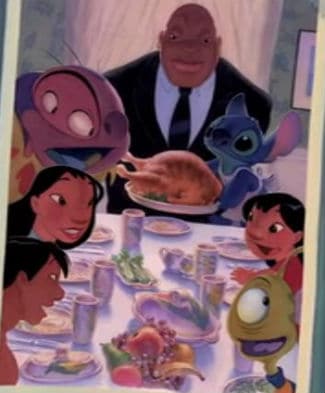
Photo: Disney
Another lesson is that most people aren’t just good or bad. There are no real villains in Lilo & Stitch, just a lot of humans and aliens trying to do what they think is the best thing to do. Some of the choices are selfish, but that’s also very human.
DOES IT HOLD UP?
I personally love this movie; it’s just the right blend of funny and heartwarming. It makes me laugh and cry in equal parts, and not only is the story one of the riskier that Disney has done (it’s about an orphan alien monster and a little girl who may be taken away from her last surviving family member), but the animation and the music are both stunning. As a wonderful story with a wonderful setting, if you haven’t seen Lilo & Stitch, check it out! If you have seen it, it’s just as good after multiple viewings.
For next week: Treasure Planet
If you enjoyed this post and the others in the Revisiting Disney series, and have found yourself wishing that you could find them all in one convenient and bound book with eight extra essays, there is an option for you! Check out A Journey Through Disney: My Look Back Through Disney Canon, now available on Amazon as both a Kindle book ($4.99) and a paperback ($11.99).
OTHER SOURCES:
https://thewaltdisneycompany.com/about-disney/disney-history
http://www.imdb.com
http://studioservices.go.com/disneystudios/history.html
http://www.thepeoplehistory.com
Bailey, Adrian. Walt Disney’s World of Fantasy. Everest House Publishers. New York, New York. 1982.
Finch, Christopher. The Art of Walt Disney: From Mickey Mouse to the Magic Kingdom. Harry N. Abrams, Inc. New York, New York. 1975.
Johnston, Ollie and Frank Thomas. The Disney Villain. Hyperion. New York, New York. 1993.
Thomas, Bob. Disney’s Art of Animation From Mickey Mouse to Hercules. Hyperion. New York, New York. 1992.
ARE YOU A ROMANCE FAN? FOLLOW THE SILVER PETTICOAT REVIEW:
 Our romance-themed entertainment site is on a mission to help you find the best period dramas, romance movies, TV shows, and books. Other topics include Jane Austen, Classic Hollywood, TV Couples, Fairy Tales, Romantic Living, Romanticism, and more. We’re damsels not in distress fighting for the all-new optimistic Romantic Revolution. Join us and subscribe. For more information, see our About, Old-Fashioned Romance 101, Modern Romanticism 101, and Romantic Living 101.
Our romance-themed entertainment site is on a mission to help you find the best period dramas, romance movies, TV shows, and books. Other topics include Jane Austen, Classic Hollywood, TV Couples, Fairy Tales, Romantic Living, Romanticism, and more. We’re damsels not in distress fighting for the all-new optimistic Romantic Revolution. Join us and subscribe. For more information, see our About, Old-Fashioned Romance 101, Modern Romanticism 101, and Romantic Living 101.

Comments are closed.